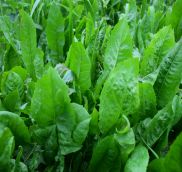WANG Honglin, ZUO Yanchun, YAN Xu, ZHOU Xiaokang, KOU Jing, DENG Wuming, XIAO Lian, SONG Xi, DAI Bingbing, YU Qingqing, DU Zhouhe
The paper aims to select new forage rape varieties suitable for planting in northeast Sichuan. Six new double-low rape lines were used as experimental materials. The biological yield, botanical characteristics, nutritional components, dynamic changes of agronomic characters and nutritional quality during cutting were recorded, and their feeding value was evaluated. The results are as follows. (1) The lines regenerated during cutting at the early flowering stage, and they could be cut twice in the whole growing season, with a cutting interval of 35-37 days. The fresh grass yield was 43.24-50.89 and 13.94-20.03 t/hm2 respectively for the two cutting, the annual fresh grass yield was 57.40-70.46 t/hm2, and the annual hay yield was 6.11-7.28 t/hm2. Among the rape lines, the fresh grass yield of ‘Zhongmianyou 783’ was the highest, which was 70.46 t/hm2 and significantly higher (P<0.05) than that of other test lines. (2) Different rape lines showed significantly different agronomic characters at the first cutting. The plant height of ‘Nanyou 714’ was the highest, up to 162.11 cm; ‘Zhongmianyou 783’ had the largest number of leaves (19.11), and the stem leaf ratio of ‘Nanyou 658 ‘was the lowest, which was 0.91. (3) The crude protein content of ‘Nanyou 12’ was 15.64% at the first cutting, which was significantly higher (P<0.05) than that of other test lines, neutral detergent fiber of ‘Zhongmianyou 783’ was the lowest (25.65%), and acid detergent fiber of ‘13Za768’ was the lowest (20.80%). (4) With the advance of the growth period, the plant height of each line increased gradually, and the plant height did not change in the late pod setting stage. The number of leaves increased first and then decreased, and the number of leaves was the most at the initial flowering stage. The dry matter content and stem leaf ratio increased continuously with the advance of the growth period. (5) The crude protein content of each line decreased with the advance of the growth period, and was the highest at initial flowering stage, which was 12.87%-15.64%. The change trend of neutral detergent fiber and acid detergent fiber were the same, and most of them increased with the advance of the growth period. The content of crude ash decreased with the advance of the growth period. Most of the crude fat increased first and then decreased, and reached the highest at full flowering stage. The feeding value of the first cutting of each rape line was 231.20-262.47, and there was no significant difference (P<0.05) between ‘Zhongmianyou 783’ and ‘13Za768’, but the feeding value of the two lines was significantly higher than (P<0.05) that of other lines. ‘Zhongmianyou 783’ has the best comprehensive performance in the test site and can be popularized and utilized in similar ecological areas.
